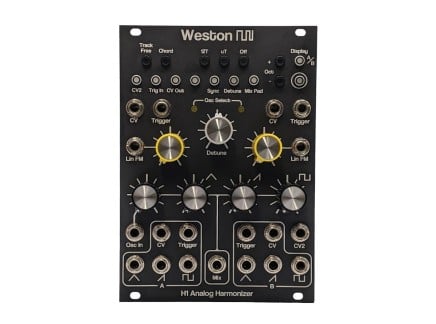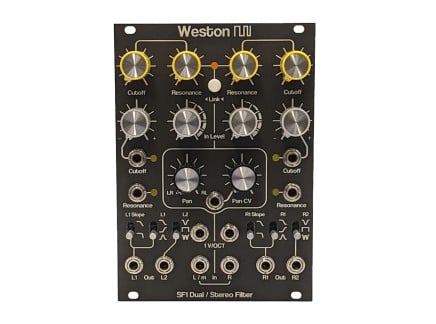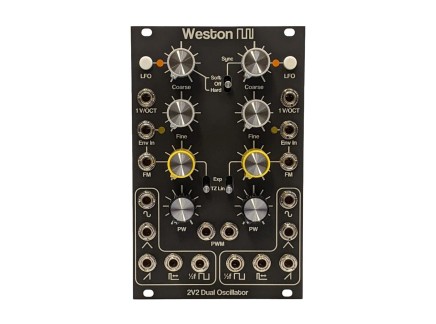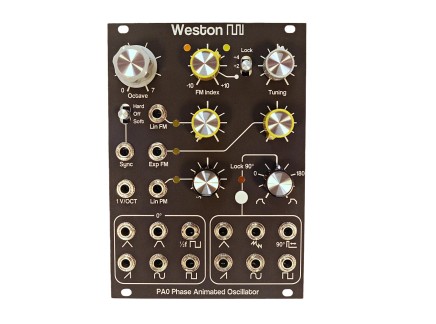One of the most interesting aspects of Eurorack modular synthesizers is the sheer number of musical perspectives presented by instrument makers. The core values of a designer can become quite clear by observing the evolution of their output—the more they make, the clearer their intent comes into focus.
Devin Weston of Weston Precision Audio got his start in synthesizer manufacturing through the synth DIY universe: having learned a lot from the synth DIY community, his first commercial endeavors were focusing on giving back to those that had taught him so much. Now, after years of development, his design ideologies have become clearer. Weston believes in analog designs, and strives to make his instruments as analog as possible; he strives to create easy-to-understand, no-nonsense user interfaces; and he still creates instruments with a strong focus on accessibility for DIY builders, offering kits for many of his modules.
We had the chance to sit down and talk with Weston about the course of his development as an instrument maker, his thoughts about the ever-evolving world of Eurorack modular synthesizers, and of course, his newest release—the H1 Analog Harmonizer. This is what he had to say.
Interview with Weston Precision Audio
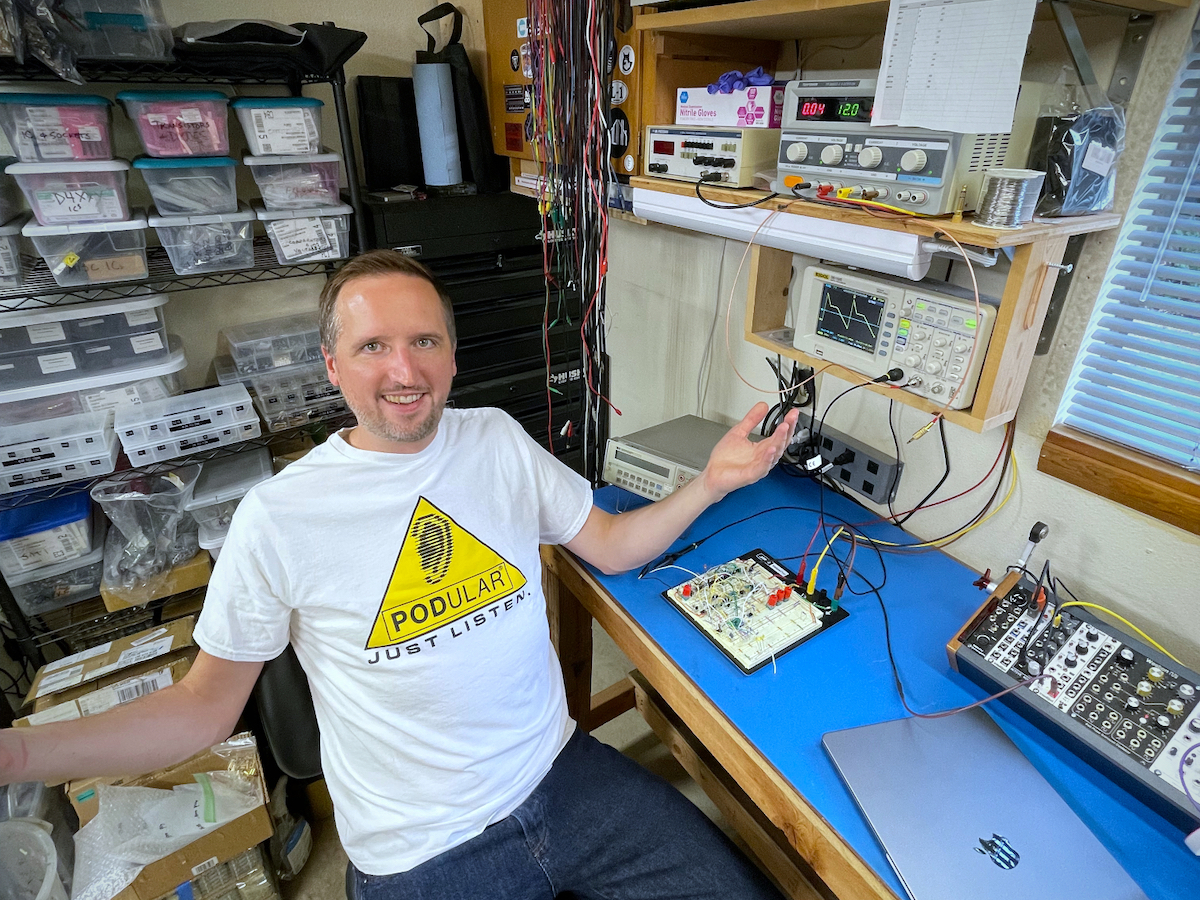
Eldar Tagi: Hi Devin, thank you for chatting with us. Let's start with an overview of your journey? Specifically, what kindled your interest in synthesizers? And what ultimately led to the creation of Weston Precision Audio?
Devin Weston: Thanks so much! It’s a pleasure to talk to you. Thinking back, I would say that I’ve always been interested in music. My first instrument was drums, and I still play them to this day, but at some point, when I was around 12, I became interested in electronic music. My folks would occasionally get me the UK magazine Future Music, which was very expensive to get stateside, and I would just swoon over the amazing gear in there. The coolest part was the CD of the user-submitted music with each issue. There was always amazing stuff on there!
During this time period, my dad acquired a vintage ARP Odyssey that had actually been used for sound effects in the planetarium in a museum. This was before “vintage hysteria” had set in, and nobody cared about old stuff like that. The synth sat for so long, not working, because I just didn’t know what to do with it. But at some point, I decided I was going to fix the thing, so I did. I tore it apart and got the schematics and started studying everything. Now armed with a little basic electronics knowledge I had learned while in school for Mechanical Engineering, I was able to piece together what was going on and completely restored it.
Once I heard the sweet tone magic from that thing, I was hooked. First, I started designing stuff for DIY people, because I had learned so much from some of the amazing folks on the ModWiggler forum, and I figured I’d try and give back to the community. So, I started Weston Precision Audio to do that, and then eventually started making complete modules as well as the DIY stuff.
ET: At the core of your design philosophy, what would you say are the essential principles that guide your approach to synthesizer design?
DW: My philosophy is, firstly, that the human ear is an analog device and we live in an analog world. Thus, the more stuff that can stay analog, the better, in my opinion. Things that cannot be done with analog is where digital can really step in, but if it can be analog, then I would prefer it this way.
Secondly, I think that modular synths are truly hands-on instruments and that modules should be relatively easy to control and patch. I think sometimes people get carried away, as an engineering exercise, making some like 6HP module with a little screen, 10 mini pots, and a bunch of jacks, but I just don’t get it. It’s like…yeah, that works and does really cool stuff but I can’t even fit my fingers in to turn the little knobs! Maybe some folks dig that sort of thing, and I mean no shade to any module builders, but I’m just saying I strive to not design anything like that.
ET: Can you recall the first instrumnet you ever created? How did this initiate experience shape your subsequent work, and what key lessons have you carried forward from it?
DW: Well, the first thing I made under the WPA name was a Pro-One based DIY synth called PRO2021. I had the mechanics of the enclosure and all that down pat because I’ve worked as a mechanical engineer for so many years, but I ended up learning a lot more about circuits while studying the Pro-One stuff.
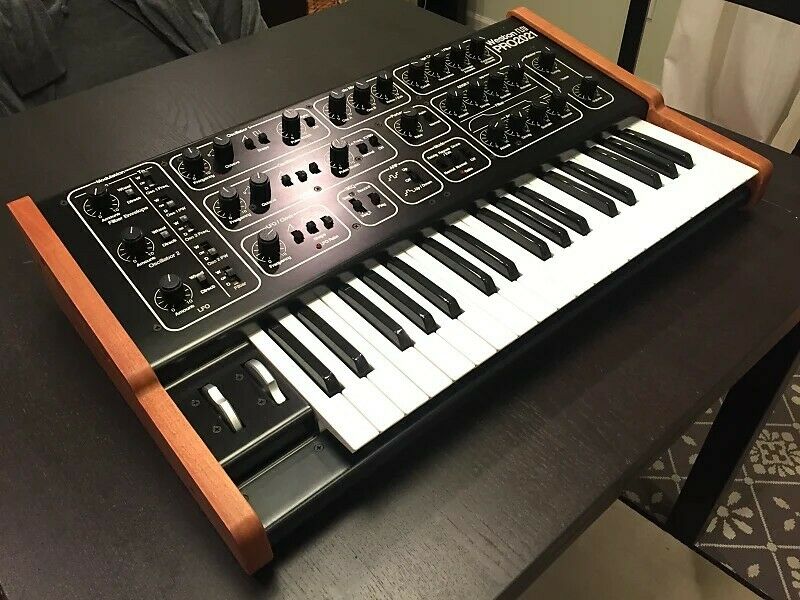
[Above: a Weston Precision Audio PRO2021]
I also learned a lot about manufacturing logistics. For example, the aluminum pitch bender assemblies I designed are a pain to build and take a ton of time. Sometimes when you are designing something on a screen you forget that someone has to build the thing. And that someone, in this case, is going to be me, in my little shop in the back yard!
ET: Weston Precision Audio now seems to have an exclusive focus on Eurorack format modules. Can you elaborate on your decision to create specifically for modular systems instead of standalone instruments?
DW: I started into modular because it was a very nice platform to focus on single functionality. Designing a standalone synth is a huge endeavor for a small company and can take years with multiple people.
On the other hand, it’s realistic for a one- or two- or three-person modular company to develop a whole module in six to nine months, which is really nice. I stick with Eurorack simply because it’s the most popular format. Sure, it has tons of unoptimized parameters, but it’s widely adopted, and growing rapidly. I’d still consider doing other formats though, in time.
[Above: some of the best-selling Weston Precision Audio modules at Perfect Circuit—the 2V2 Dual Oscillator, PA0 Phase Animated Oscillator, and SF1 Dual / Stereo Filter]
ET: In your experience, what are the most challenging aspects of synthesizer design? Conversely, what aspects are you finding to be the most fulfilling?
DW: The most challenging aspect, by far, is trying to come up with something that is, at least to some degree, original. The market has gotten so big that you can come up with a really good filter, or VCA, or something, but there will also be hundreds of other really good filters or VCAs to compete with.
My favorite aspect of designing synths is hearing somebody use something I’ve made in some music or a performance, or just simply having someone say they enjoy using a module I’ve made.
ET: Weston Precision Audio offers a diverse range of modules, including oscillators, drum modules, effects, and utilities. If someone new to the modular world were to start their journey with a WPA module, which one would you recommend and why?
DW: Well, my first recommendation would be for the person to reconsider modular, because they are about to ruin their life and spend all their money!
Kidding aside, I would always ask what type of music the person wants to make and go from there. The use cases of a modular synth are huge. Like, some people make some really crazy minimal noise music, and some people want lush, melodic stuff. The modules you need to make those two different things are quite different. That being said, you can’t really go wrong with having a good oscillator, and we have several to choose from, so I would recommend starting there.
ET: Shifting our focus to the new H1 Analog Harmonizer module—it truly is a fascinating design. Can you share with us what has initially inspired you to develop this particular module?
DW: With H1, I was trying to make something that would make it easy to add some more “polyphony” to modular, but not in a traditional polysynth sense. There are already modules that parse out CVs and gates so that you can get, for example, three VCOs, three VCFs, three Envelopes, and three VCAs, and play your modular with a keyboard like a polysynth.
But that is a lot of hardware and patching to essentially recreate a polysynth. On the other hand, you can just plug one VCO into H1 and get a 3 part analog chord oscillator out of the mix output right way with just one patch cable.
ET: How was the process of developing this module for you? Were there many challenges? If so, what were they, and how did you overcome them?
DW: This module took longer than anything I’ve made so far. The oscillator parts are fully analog, but all the “brains” are digital, so there’s a ton of code that I had to write. My friend, Jim Coker from Five12 is a legitimate C/C++ genius, and I messaged him a bunch during development with my stupid coding questions. He’s a great guy and always helps out, and I really appreciate that.
ET: How has the Eurorack community responded to the H1 so far? Are there any user experiences or performances using it that stand out to you?
DW: The interest has been really good for this module. I was able to show it to a ton of folks at Superbooth, and then the demo video I created got a lot of watches and good responses right off the bat.
Right now, I’ve got units in the hands of some great music-creating folks, and have been spending some time working with them in a process where they help me refine the firmware while I help them understand how to use the module. I hope that they’ll have some cool musical output using the module here in the near future.
[Devin Weston at work on the H1 Analog Harmonizer]
ET: Can you share a bit about your vision for the future of Weston Precision Audio? Are there any upcoming projects or module designs you can hint at?
DW: Right now my plan is to just keep trying to make new stuff that is musically useful and hopefully has some elements of originality. Our current lineup of modules doesn’t really include any VCAs or envelopes, so I do plan to look into those areas to help build out the product offerings. I also plan to try and do more stuff for the DIY community, because I don’t want to forget those folks, and they’ve been asking for more stuff to build!
ET: In retrospect, as a founder and designer, can you share some of your most significant milestones or achievements with Weston Precision Audio that make you particularly proud?
DW: Yeah, defintely. I recently had a musician, who has some pretty big releases in the house music world, buy a couple of B2 Bass/Kick Drum modules from me and said they had bought tons of other analog kick module and the B2 was their favorite. That made my day for sure!
ET: As we conclude, what sort of advice would you give to someone who is just beginning to explore the world of Eurorack synthesizers?
DW: First, I would say to not worry about being overwhelmed by the sheer amount of options and money that can be spent on modular. Know that it will be a journey and even if you could spend $1 million on modular gear right now, you probably wouldn’t know how to use all of it right away anyway, so It’s best to just take it one step at a time.
That’s one of the lessons I learned about music gear a long time ago: that it’s much more productive to learn how to really use what you’ve got than to chase gear lust. Like, I still play a four-piece drum kit with the same cymbals I’ve had for 15 years and I’m still not bored with them. If there’s a problem, it’s only that I haven’t practiced enough! Of course, I realize I’m being a really horrible salesman right now, but hey, I can’t help but be honest!





